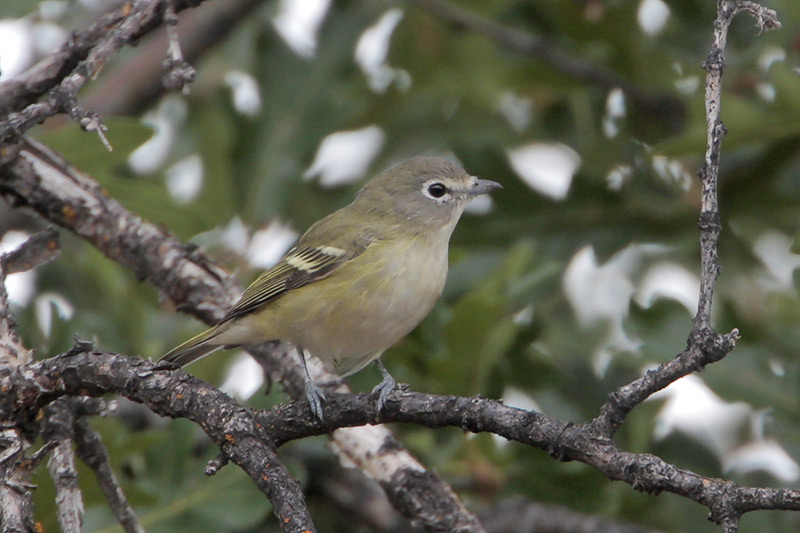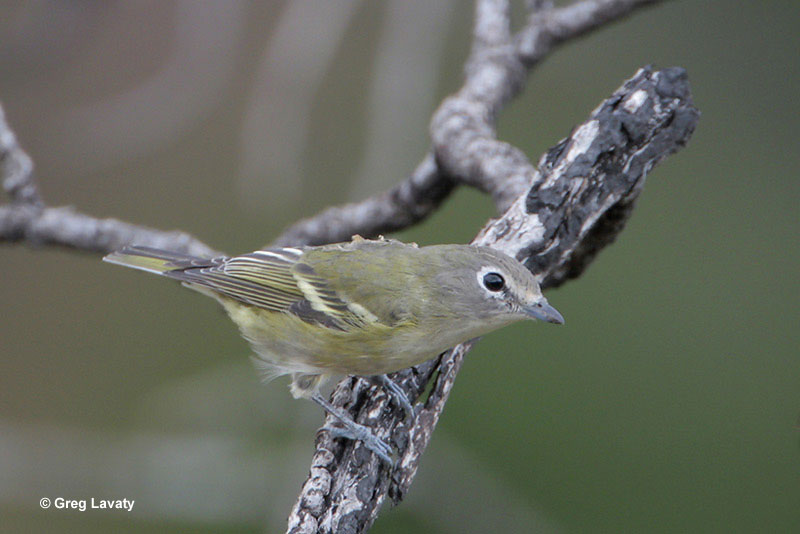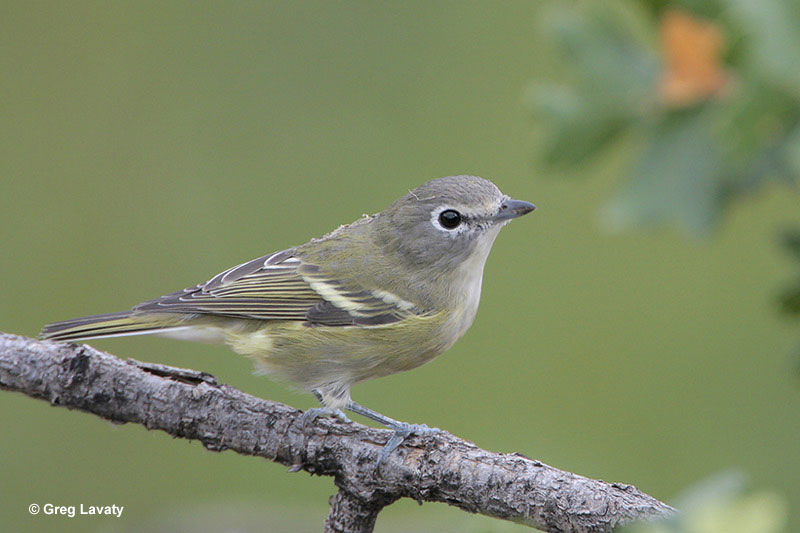The Cassin’s Vireo is the westernmost breeding member of the three species of vireos that were formerly considered to be a single species called the Solitary Vireo. Cassin’s Vireos have occurred as vagrants as far east as the East Coast.
Vireos as a group are very frequently parasitized by Brown-headed Cowbirds, and the Cassin’s Vireo is no exception. Despite this, the Cassin’s Vireo population has been increasing in recent years.
On this page
Description of the Cassin’s Vireo
BREEDING MALE
The Cassin’s Vireo has a gray head and greenish upperparts, white spectacles, whitish underparts, and greenish wings with two wing bars.

Photograph © Greg Lavaty.
Female
The sexes are similar.
Seasonal change in appearance
None.
Juvenile
Juveniles are similar to adults.
Habitat
Cassin’s Vireos inhabit coniferous and mixed forests.
Diet
Cassin’s Vireos eat insects.

Behavior
Cassin’s Vireos forage rather deliberately in trees.
Range
Cassin’s Vireos breed across much of the far western U.S. and southwestern Canada. They winter in Mexico. The population appears to be increasing.
More information:
Bent Life History
Visit the Bent Life History for extensive additional information on the Cassin’s Vireo.
Fun Facts
The Cassin’s Vireo was formerly considered to be a subspecies of Solitary Vireo, a species since split into Plumbeous, Cassin’s, and Blue-headed Vireos.
Cassin’s Vireos actively defend their nests by scolding and even diving at intruders.
Vocalizations
Calls include a series of “cheh” notes, while the song consists of a two-or-three syllable series of slurred notes.
Nesting
The Cassin’s Vireo’s nest is a cup of leaves, weeds, bark fibers, and other plant materials, and is typically placed on a forked twig of a tree.
Number: Usually lay 4 eggs.
Color: White with darker markings.
Incubation and fledging:
The young hatch at about 13-14 days, and leave the nest in about another 13-14 days, though continuing to associate with the adults for some time.
Bent Life History of the Cassin’s Vireo
Published by the Smithsonian Institution between the 1920s and the 1950s, the Bent life history series of monographs provide an often colorful description of the birds of North America. Arthur Cleveland Bent was the lead author for the series. The Bent series is a great resource and often includes quotes from early American Ornithologists, including Audubon, Townsend, Wilson, Sutton and many others.
Bent Life History for the Cassin’s Vireo – the common name and sub-species reflect the nomenclature in use at the time the description was written.
VIREO SOLITARIUS CASSINI Xantus
Cassin’s vireo is the westernmost race of the species, breeding from the Rocky Mountains westward and mainly in the Transition Zone, from central British Columbia to northern Lower California. It differs from the eastern blue-headed vireo in being slightly smaller and much duller in color.
In the northern portion of its range, Cassin’s vireo seems to prefer the forests of pines and firs, where there is a mixture of oaks or other deciduous trees among the conifers. S. F. Rathbun tells me that it is a regular and not uncommon summer resident about Seattle, Wash., where it prefers the rather open sections of the forest where there is a somewhat scattered growth of trees; he also finds it where there is a mixture of deciduous trees among small firs, but considers it rather partial to oaks.
Gabrielson and Jewett (1940) say that, in Oregon, “it is found in the smaller second growth and in brushy areas either on the hillsides or along the stream bottoms. * * * It breeds commonly and builds its dainty nest low in bushes or trees.” Dr. J. C. Merrill (1888) writes: “Unlike most Vireos this one, as observed at Fort Kiamath, shows a marked predilection for pines and firs, and is found almost everywhere among these trees. It is also found, but much less frequently, in aspen groves with the Warbling Virco. The nests are built in low mauzanita or buck-rush bushes that grow throughout the pine woods.” Grinnell and Storer (1924) write:
The Cassin Vireo is a summer visitant at middle altitudes along the west flank of the Sierra Nevada. Its distribution at nesting time closely parallels the ranges of the golden oak and Incense cedar, though the bird does not restrict Itself exclusively to these two trees. In and around Yosemite Valley this species and the Western Warbling Vireo are often to be found together, although the Cassin shows preference for the drier portions of the Valley, for example, near and upon the talus slopes along the north and south walls. During the spring migration the Cassin Vireo is a common transient in the western foothill country where, during its passage, it is to be seen in blue oaks and chaparral on dry hillsides. In early fall after the young are grown a few of these vireos wander up Into the Hudsonian Zone before taking final leave of the country for the winter.
Howard L. Cogswell writes to me: “In the San Gabriel Mountains, the area where I have seen most of my Cassin’s vireos, they are definitely associated in the breeding season with the oaks along the walls of the lower mountain canyons and throughout the big-cone spruces and golden-cup oaks and into the lower edges of the pines of the Transition Zone. They are not often found in the alders and sycamores along the bottom of the larger canyons, and in the valley areas occur only in migration.”
Nesting: Thomas D. Burleigh (1930) reports five nests found near Tacoma, Wash. The first “was twelve feet from the ground at the outer end of a limb of a small scrub oak in a stretch of open fir woods, and was built of grasses and usnea moss, lined with fine grasses and bright red moss rootlets, and well ornamented on the outside with white spiders’ egg cases and bits of dead leaves. * * * Within the next month four other nests were found, and two of them were in small oaks and two in alder saplings, varying in height from five to ten feet from the ground.”
Mr. Rathbun has sent me the following description of two nests of the Cassin’s vireo, found in that same region :’ ‘The nest is a cupshaped affair and is attached by its upper edges to the horizontal fork of a limb, generally at no great height. It is neatly made, reflecting skill in its construction. The material used for the outer part of one consisted of pieces of dead leaves of various dull colors, some bits of heavy gray paper, dry gray grasses and a small quantity of greenish-gray moss, these materials being interwoven and bound firmly by tough plant fibers. The lining was entirely of fine, dry grasses. The general color effect of this nest was a composite one, formed of many neutral tints, harmonizing with the lichen-covered limbs of a small oak, in which it was built. The outside of the nest was decorated with pieces of white cocoon.”
Of the other, he says: “This nest was attached, pendantly, to a shaped fork near the extremity of a lower limb of a young fir, at a height of about 15 feet, the top of the nest being screened from view by a small twig overarching it. The material used consisted of many small pieces of thin, soft, dead leaves, long dry grasses, with a few horsehairs interwoven to help bind them and give strength; the nest was firmly bound to its support by strips of dry moss and vegetable fibers. The lining was of fine fibers, small stems of leaves, and a few horsehairs; the outside of the nest was decorated with a few pieces of white cocoons. On the twigs to which it was attached grew a few lichens, and a few of these were scattered about the upper part of the nest. Diameter outside, 31/4 inches; height, 21/4 inches; diameter inside, 214 inches; depth, 134 inches.”
Dawson and Bowles (1909) say that some nests are placed as much as 30 feet above the ground, and Mr. Bowles adds: “They are the quickest as well as the slowest birds in completing their nests that have come under my notice. One pair built a handsome nest and laid four eggs in precisely ten days; while another pair were more than three weeks from the time the nest was started until the eggs were laid. They are the only Vireos that I have ever known to nest in communities.
Single pairs are the rule, but I have found as many as six occupied nests inside of a very small area, t.he nests being only a few yards apart.”
J. Stuart Rowley writes to me: “There is an apple orchard in Tulare County, Calif., at an elevation of about 4,600 feet, where I have had an ideal chance to observe the nesting habits of this vireo. Here it seems that apple trees are favorite nesting trees, and many pairs breed here every year. The first week in June is the height of the egg-laying time, and many nests containing eggs can be found. Often a nest of cassini will be found in one tree, while in the very next tree not 20 feet away will be a nest of the western warbling vireo.”
In the Yosemite Valley, Grinnell and Storer (1924) found a nest on May 22, 1919. “It was placed in an incense cedar at the edge of Merced River., The nest was on a branch which extended out over the rushing stream and was about 18 feet above the surface of the water.” Dr. Grinnell (1908) found another nest “twelve feet from the ground in the, lower outer foliage of an incense cedar growing among fire,” in the San Bernardino Mountains.
Eggs: Cassin’s vireo lays three to five eggs; four is the usual number, but sets of five are not very rare. They are like the eggs of the eastern races, white or creamy white, and sparingly spotted with different shades of light or dark or reddish brown, the spots apparently averaging lighter and brighter browns than with the eastern blueheaded vireo. The measurements of 40 eggs in the United States National Museum average 19.4 by 14.3 millimeters; the eggs showing the four extremes measure 22.4 by 14.7, 21.3 by 15.2, 17.3 by 14.2, and 18.0 by 13.2 millimeters.
Food: A separate study of the food of Cassin’s vireo was made by Prof. F. E. L. Beal (1907), who examined the contents of 46 stomachs, taken in every month from April to November. He says:
The vegetable food, which was Only a little more than 2 percent of the total, was made up of leaf galls, seeds of poison oak, and a few bits of rubbish. Not a trace of fruit was found.
The animal matter amounts to nearly 98 percent of the whole. Hemiptera are the largest item and amount to nearly 51 percent. The various families represented are those of the squash-bugs, leaf-bugs, stink-bugs, shield-bugs, leaf-hoppers, tree-hoppers, the Jumping plant-lice, and scales. The latter are represented as usual by the black olive scale, which was contaiiied in four stomachs. Caterpillars, with a few moths, are next in importance and form more than 23 percent of the whole food. They were eaten in every month and are evidently a favorite diet.
[Hymenoptera] amount to over 7 percent, and are mostly wasps, with a few ants. * * * Ladybird beetles were eaten to the extent of a little less than 6 percent, which is quite reasonable as compared with the record of the warbling vireo. * * * Other beetles amount to a little more than 3 percent of the food, and are mostly weevils and small-leaf-beetles (Chrysomelidac). A few flies, grasshoppers, and other Insects amount to somewhat more than 2 percent, and these, wIth 4 percent of spiders, make up the remainder of the animal food.
Fall: Although most individuals of the species breed in the Pacific States, mainly west of the Rocky Mountains, Cassin’s vireos migrate southeastward in the fall, through Utah, Colorado, Arizona, and New Mexico, to their winter resorts in Mexico.


